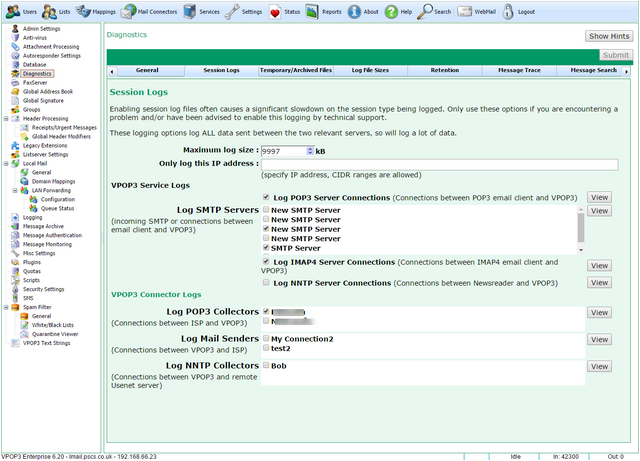
To get to this page, go to Settings → Diagnostics → Session Logs
Session Logs record the full conversation between VPOP3 and other computers at the raw protocol level (without any session encryption). They can be used for trying to find why message sending or collection isn't working, but generally they will require some knowledge of the underlying Internet protocol, such as SMTP, POP3 or IMAP4 as well as the Internet Message format standards.
These log files can log a lot of data, especially if your server is busy, so you will probably need to consider setting the log file Retention settings as well otherwise the log may have been overwritten by the time you come to look at it. Enabling these log files will also slow things down. Generally we recommend they are turned off unless you have been asked to turn them on by one of our technical support representatives.
The Maximum log size setting tells VPOP3 how big to allow each log file to grow. This is the same for each log file on this page. When the log file fills up, VPOP3 renames it to *.LBK (after deleting any existing *.LBK file) and starts a new *.LOG file. See the Log File Sizes and Retention tabs for more information.
The Only log this IP address option lets you filter session logging by the remote computer's IP address which may be helpful if trying to diagnose a problem with a particular remote server or client. Enter the remote computer's IP address or subnet (use CIDR ranges if required - eg 192.168.1.0/24)
The VPOP3 Service Logs section configures logging for VPOP3 services - the parts of VPOP3 which provide services to email clients. This is usually where you need to log if there is a problem with the mail software on a user's computer or device. The SMTP service is also used for incoming SMTP messages.
If you just have one service defined of a particular type (always in VPOP3 Basic and by default in VPOP3 Enterprise), then you will just have one checkbox, as above for Log POP3 Server Connections. If you have multiple services defined (as above for SMTP), it will list the various services in the group with a checkbox for each.
The VPOP3 Connection Logs section defines logging for VPOP3 connectors - the parts of VPOP3 which communicate with remote mail servers. This is where outgoing SMTP mail is logged when being sent to a remote SMTP server and incoming POP3 from a remote POP3 server is logged. The various Mail Collectors and Senders you have defined can have logging turned on individually here.
The View buttons let you see the current log file of the particular type. The log files are also stored in the VPOP3 logging directory (defined on the General tab) as:
•Log POP3 Server Connections - POP3SVR.LOG
•Log SMTP Servers Connections - SMTPSVR.LOG
•Log IMAP4 Server Connections - IMAPSVR.LOG
•Log NNTP Server Connections - NNTPSVR.LOG
•Log POP3 Collectors - POP3CLT.LOG
•Log Mail Senders - SMTPCLT.LOG
•Log NNTP Collectors - NNTPCLT.LOG
Note that all connections of a particular type are logged in the same log file.
When the log file fills up, it is renamed to <whatever>.LBK, and a new .LOG file is created.

